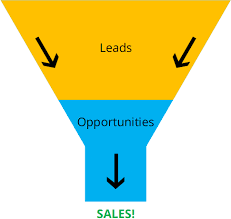To identify and classify potential customers into opportunities, businesses often apply different marketing methods and strategies. Here are some common methods for identifying and classifying leads into opportunities:
- Analyzing customer characteristics: This includes collecting and analyzing information about customers such as age, gender, location, income, preferences and previous purchasing behavior. Analyzing this data can help identify specific groups of potential customers that a business can focus on reaching.
- Gauge interest: A common way to identify potential customers is to gauge their interest in the product or service a business offers. This can be done through gathering information through surveys, tracking behavior on the website, or looking at past interactions such as social media interactions or document downloads.
- Assess ability to pay : To identify customers with the potential to become opportunities, assessing their ability to pay is very important. Information such as income, credit history, or investment capacity can be used to evaluate a customer’s ability to pay and purchasing ability.
- Tracking behavior on your website: Tracking customer behavior on your business’s website can provide important information about customer interest and engagement. Tracking activities like product views, time spent on site, or interactions with call-to-action buttons can help identify leads.
- Use artificial intelligence and machine learning technology: Artificial intelligence and machine learning technology can be applied to identify and classify leads into opportunities. Machine learning algorithms and models can be trained to predict customers who are likely to purchase and actively interact with a business.
- Online behavior and activity characteristics: Track your leads’ online activities, including tracking website behavior, social media interactions, and responses via email or other forms other contact.
- Demographic Data : Analyze data on age, gender, geographic location, occupation and income to better understand potential customers.
- Historical behavioral data: Review past transactions, product/service interactions, and feedback from potential customers.
- KPIs (Key Performance Indicators) : Determine key performance indicators such as conversion rate, purchase quantity, purchase frequency, and average order value to evaluate customer potential.
- Lead Scoring : Uses a scoring system to determine the potential level of each customer based on the information they provide and their behavior.
- Lead scoring: Lead scoring is a method used to rank and prioritize leads based on their likelihood of becoming an opportunity. It involves assigning numerical values or scores to various attributes and behaviors of potential customers. These attributes can include demographic information, engagement, response to marketing campaigns, etc. By scoring leads, businesses can focus their efforts on those who leads with the highest scores, indicating higher conversion potential.
- Customer segmentation: Customer segmentation involves dividing customers into distinct groups based on common characteristics or behaviors. By segmenting customers, businesses can tailor their marketing strategy to the specific needs and preferences of each segment. Segmentation can be based on a variety of factors such as demographics, psychographics, purchase history or interaction patterns. Identifying segments that represent potential opportunities allows a business to target its marketing efforts more effectively.
- Referral and Recommendation Analysis: Analyzing referrals and recommendations from current customers can be a valuable method for identifying potential customers. Satisfied customers who recommend a business to others or give positive recommendations often show a higher likelihood of conversion. By tracking and analyzing referral sources, businesses can identify patterns and target similar leads who are more likely to become opportunities.
- Track engagement and engagement : Monitoring customer engagement and engagement across different channels can provide valuable insights into potential opportunities. Tracking metrics like email opens, click-through rates, social media interactions, and website behavior can help identify leads who demonstrate higher levels of engagement. Leads who actively engage with your business’s content or show interest in specific products or services are more likely to convert into opportunities.
- Qualitative research and surveys: Conducting qualitative research and surveys can provide deeper insights into customer needs, pain points, and motivations. By interacting directly with potential customers through interviews or surveys, businesses can gather valuable feedback and understand their preferences and purchasing intentions. This information can help identify leads that are a good fit for your business’s offerings and have a higher chance of becoming an opportunity.
The process of identifying and classifying leads into opportunities is often an ongoing process and requires a combination of different methods and tools. Most importantly, understand your target customers and focus on creating the right marketing strategies to optimize the conversion of leads into real opportunities.
SHARE
